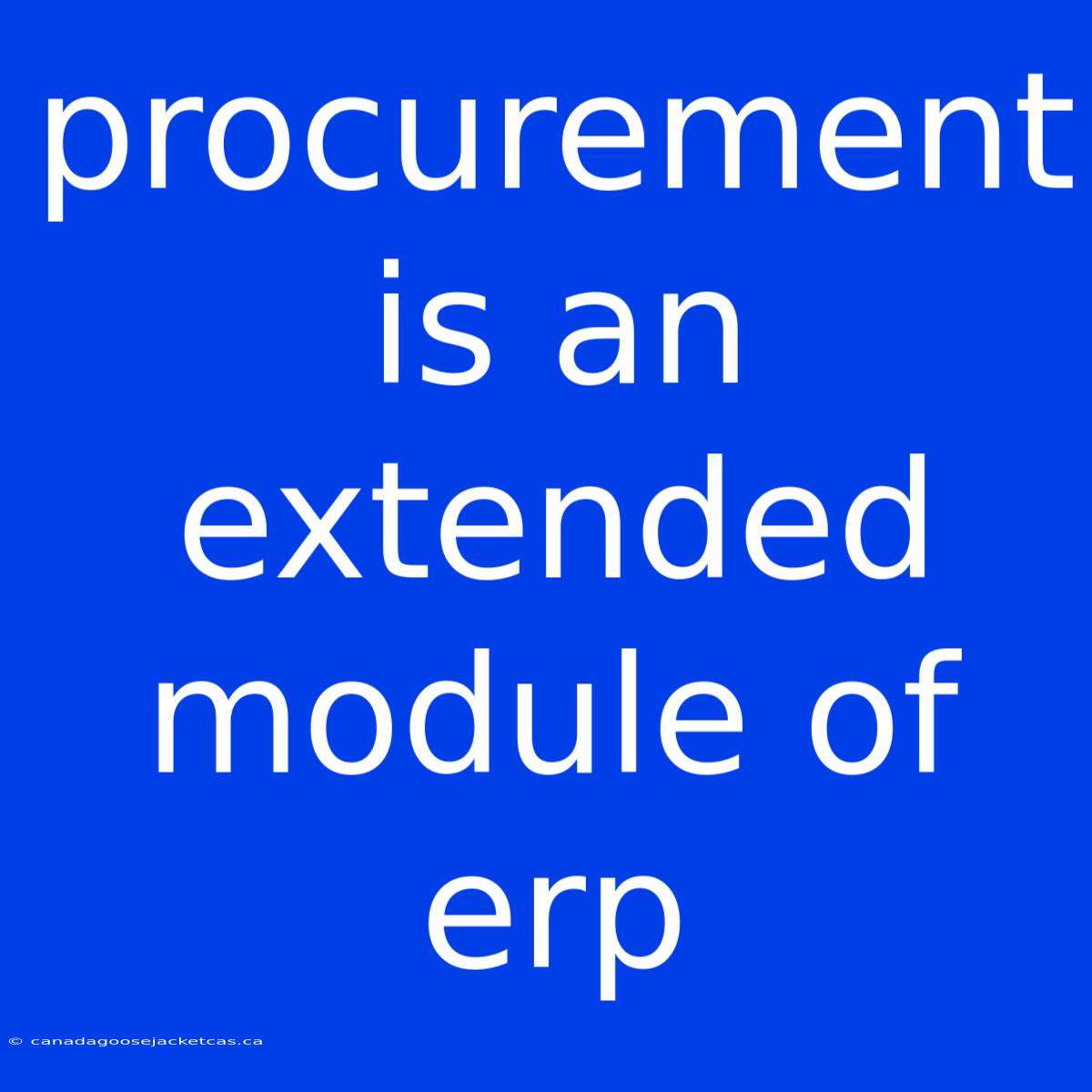Procurement: An Extended Module of ERP - Streamlining Your Supply Chain
How can procurement be considered an extended module of an ERP system? The integration of procurement into an ERP system is a game-changer for modern businesses. It allows for a unified view of the entire supply chain, improving efficiency, reducing costs, and enhancing visibility.
Editor Note: Procurement is a vital part of any organization. Understanding its integration with ERP systems can unlock significant operational and financial advantages.
This article delves into the world of procurement, exploring its key aspects as an extended module of ERP. We will discuss its importance, benefits, and how it can help businesses optimize their supply chain operations.
Analysis: We conducted extensive research, examining best practices and analyzing industry trends to compile this guide. Our goal is to equip businesses with the information they need to make informed decisions regarding their procurement processes and ERP integration.
Key takeaways of Procurement Integration with ERP:
| Benefits | Details |
|---|---|
| Increased Efficiency | Streamlined processes, automated tasks, reduced manual errors. |
| Reduced Costs | Optimized purchasing, better price negotiation, minimized waste. |
| Enhanced Visibility | Real-time tracking of orders, inventory levels, and supplier performance. |
| Improved Compliance | Automated workflows ensure adherence to internal and external regulations. |
Procurement: An Integral Part of ERP
Procurement, a vital function in any organization, involves sourcing, purchasing, and managing goods and services. It's the bridge between a business's needs and its external suppliers.
Key Aspects of Procurement Integration:
- Sourcing: Identifying suitable suppliers, negotiating contracts, and selecting the best options.
- Purchasing: Ordering goods and services, managing purchase orders, and tracking deliveries.
- Inventory Management: Managing stock levels, optimizing storage space, and minimizing waste.
- Supplier Relationship Management: Building strong relationships with suppliers, ensuring timely deliveries, and managing performance.
- Contract Management: Negotiating contracts, tracking compliance, and managing renewals.
Discussion:
Sourcing: ERP systems empower procurement teams to access a centralized database of suppliers, enabling them to quickly identify and evaluate potential partners based on criteria like cost, quality, and delivery timelines. This fosters a competitive sourcing environment, leading to better pricing and improved product quality.
Purchasing: Integrated procurement modules simplify the purchasing process. Purchase orders are automatically generated and tracked, ensuring accurate record-keeping and reducing errors. ERP systems also facilitate the automation of repetitive tasks like order approval workflows, freeing up procurement staff to focus on strategic initiatives.
Inventory Management: Effective inventory management is critical for maintaining efficient operations and minimizing costs. ERP systems provide real-time visibility into stock levels, allowing for just-in-time ordering and reducing the risk of overstocking or stock-outs. This optimizes warehouse space utilization and minimizes warehousing costs.
Supplier Relationship Management: Building strong relationships with suppliers is essential for ensuring consistent quality and reliable deliveries. ERP systems can facilitate communication, collaboration, and performance tracking, enabling businesses to manage supplier performance effectively.
Contract Management: ERP systems streamline contract management by providing a central repository for all contracts. This allows for easy access, tracking of compliance, and timely renewal notifications, ensuring that contracts are always up-to-date and aligned with business needs.
The Benefits of Procurement in ERP:
- Improved Efficiency: By automating repetitive tasks and streamlining processes, procurement integration with ERP systems leads to significant efficiency gains. This translates into shorter lead times, reduced errors, and increased productivity.
- Cost Reduction: Optimized purchasing processes, better price negotiation, and improved inventory management contribute to significant cost savings. The elimination of manual processes and reduction of errors further minimize operational expenses.
- Enhanced Visibility: Real-time access to data on supplier performance, inventory levels, and purchase orders provides comprehensive visibility into the supply chain. This facilitates proactive decision-making and empowers businesses to respond quickly to changing market conditions.
- Improved Compliance: Automation of workflows ensures adherence to internal policies and external regulations, reducing the risk of non-compliance and minimizing legal liabilities.
FAQ
Q: What are the key considerations when implementing procurement in ERP?
A: Key considerations include:
- Business requirements analysis to identify specific needs.
- Selecting an ERP solution with strong procurement functionality.
- Ensuring data integration between systems.
- Providing adequate training for users.
Q: How can businesses measure the success of their procurement integration with ERP?
A: Key metrics include:
- Reduction in purchase order processing time.
- Decrease in inventory carrying costs.
- Improvement in supplier lead times.
- Increase in on-time deliveries.
- Enhanced supplier performance ratings.
Q: What are the potential challenges of implementing procurement in ERP?
A: Challenges include:
- Resistance to change from employees.
- Difficulty in data integration between systems.
- Complexity in customizing the ERP solution to meet specific business needs.
Tips for Success:
- Clearly define procurement goals: Establish clear objectives for the procurement process, including cost savings, efficiency improvements, and enhanced compliance.
- Choose the right ERP system: Select a system with strong procurement functionality and features aligned with business needs.
- Ensure data integration: Integrate the ERP system with existing procurement systems to ensure accurate data flow and seamless communication.
- Provide comprehensive training: Train users on the new system and processes to maximize adoption and efficiency.
- Continuously monitor and evaluate: Regularly monitor key metrics and make adjustments to the system and processes as needed to optimize performance.
Summary:
Integrating procurement with an ERP system is a strategic move that can significantly improve supply chain efficiency, reduce costs, and enhance visibility for businesses. By leveraging the power of automation, real-time data, and centralized control, organizations can transform their procurement operations, ultimately driving improved business outcomes.
Closing Message: The success of procurement integration with ERP depends on a clear vision, careful planning, and ongoing monitoring. By embracing the benefits of this powerful combination, businesses can build a more robust and responsive supply chain, paving the way for continued growth and success.

